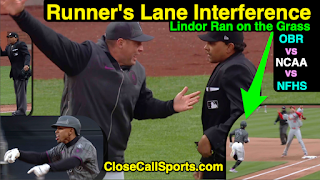We review professional baseball's runner's lane interference rule and compare this call across baseball's different levels, namely college (NCAA) and high school (NFHS). Is Lindor out for RLI at each level?
Contrary to Lindor's claim that he ran legally within the running lane—including the extended-for-2024 dirt area in fair territory—replays indicate Lindor ran entirely on the infield grass and well out of the runner's lane or "inside the line" during his jaunt to first base.
Cardinals catcher Willson Contreras' throw to first baseman Paul Goldschmidt, however, was high and Goldy was unable to catch the ball upon jumping for it. HP Umpire Bacchus' RLI call thus put an out on the board even with the overthrow.
Official Baseball Rule 5.09(a)(11) states, "A batter is out when in running the last half of the distance from home base to first base, while the ball is being fielded to first base, he runs outside (to the right of) the three-foot line, or inside (to the left of) the foul line and on the infield grass, and in the umpire’s judgment in so doing interferes with the fielder taking the throw at first base."
College has a similar rule on its face, but unlike OBR, NCAA 7-11-p has a note that states, "If the batter-runner is running illegally to first base and their being outside the lane alters the throw of a fielder, hinders or alters a fielder’s opportunity to field the throw, or the batter-runner is hit by the throw that has been made in an attempt to make a play, it shall be called interference and the batter-runner is to be called out."
This means the primary difference between college and pro is with whom the batter-runner, by virtue of running out of the lane, is interfering with. Under OBR, the only consideration is "the fielder taking the throw" while NCAA RLI provides for either the fielder taking the throw or the fielder making the throw, provided the batter-runner's illegal positioning "alter[ed] the throw of a fielder."
Accordingly, we must determine whether 1B Goldschmidt, as the fielder taking the throw, was actually interfered with by Lindor's running out of the running lane. Because of the high throw and the jump that couldn't reel it in, I'm inclined to say the throw could not have "reasonably retired the runner", which is the standard interpretation for RLI when considering questionable throw quality.
Meanwhile, high school's rule is probably the easiest as NFHS 8-4-1g states, succinctly, that a batter-runner is out when they run "outside the three-foot running lane (last half of the distance from home plate to first base), while the ball is being fielded or thrown to first base." In other words, NFHS is strict: fail to run within the lane, if there's any question of whether there was interference, you're out, period.
Also the broadcaster incorrectly stated Lindor was out for running "out of the baseline." Sigh.
Alternate Link: Bacchus calls Lindor out for RLI, running on the grass...but did he interfere?
Wrap: Houston Astros vs Chicago Cubs, 4/25/24 | Video as follows:
Alternate Link: Bacchus calls Lindor out for RLI, running on the grass...but did he interfere?











0 comments :
Post a Comment